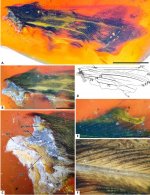Fred Ruhe
Well-known member

Lida Xing, Ryan C. McKellar & Jingmai K. O'Connor, in press
An unusually large bird wing in mid-Cretaceous Burmese amber
Cretaceous Research Article 104412 (advance online publication)
doi: https://doi.org/10.1016/j.cretres.2020.104412
https://www.sciencedirect.com/science/article/pii/S0195667119304598
Abstract: https://www.sciencedirect.com/science/article/pii/S0195667119304598
All of the bird specimens previously recovered from Burmese amber have belonged to either immature specimens, or small-bodied taxa belonging to Enantiornithes. This has led to questions about whether the size bias inherent to preservation in amber has limited inclusions to smaller individuals or species, or if the avifauna of the amber-producing forest had a stronger representation of small-bodied taxa than other Cretaceous assemblages. A newly discovered inclusion of a fragmentary bird wing is described here: specimen LV-0321 likely belonged to an individual that was in excess of 10 cm long (snout to vent length). The new specimen also displays more prominent light-and-dark banding patterns among the primary flight feathers than any of the wings previously described from the deposit. In addition to increasing the known size range for enantiornithines within the assemblage, the new specimen sheds further light on the appearance of the plumage in these Cretaceous birds.
Enjoy,
Fred
An unusually large bird wing in mid-Cretaceous Burmese amber
Cretaceous Research Article 104412 (advance online publication)
doi: https://doi.org/10.1016/j.cretres.2020.104412
https://www.sciencedirect.com/science/article/pii/S0195667119304598
Abstract: https://www.sciencedirect.com/science/article/pii/S0195667119304598
All of the bird specimens previously recovered from Burmese amber have belonged to either immature specimens, or small-bodied taxa belonging to Enantiornithes. This has led to questions about whether the size bias inherent to preservation in amber has limited inclusions to smaller individuals or species, or if the avifauna of the amber-producing forest had a stronger representation of small-bodied taxa than other Cretaceous assemblages. A newly discovered inclusion of a fragmentary bird wing is described here: specimen LV-0321 likely belonged to an individual that was in excess of 10 cm long (snout to vent length). The new specimen also displays more prominent light-and-dark banding patterns among the primary flight feathers than any of the wings previously described from the deposit. In addition to increasing the known size range for enantiornithines within the assemblage, the new specimen sheds further light on the appearance of the plumage in these Cretaceous birds.
Enjoy,
Fred




